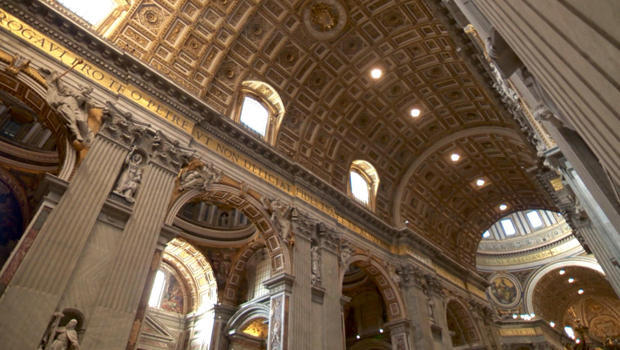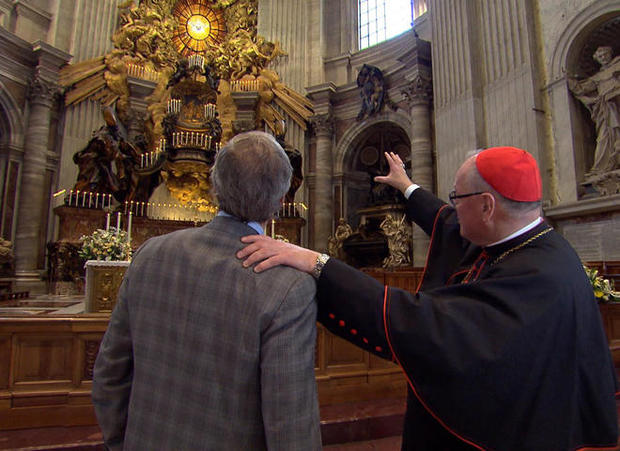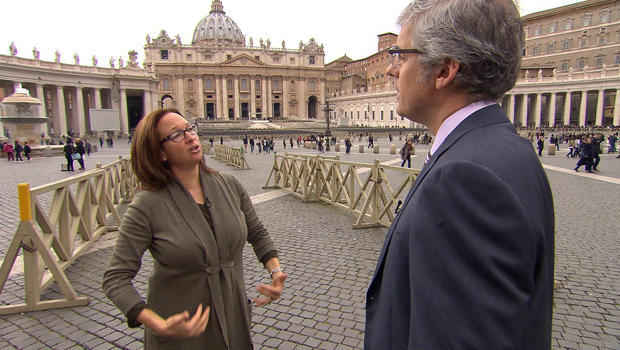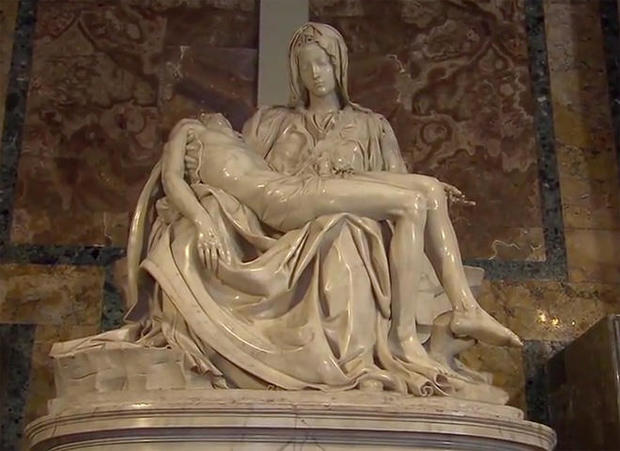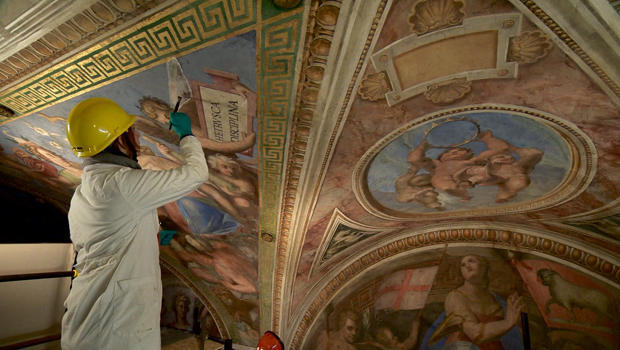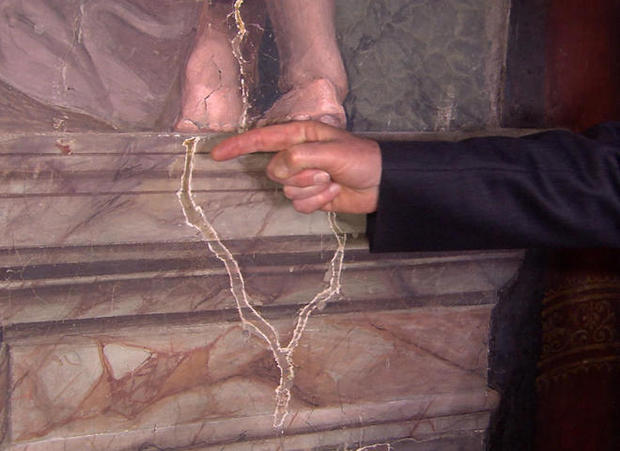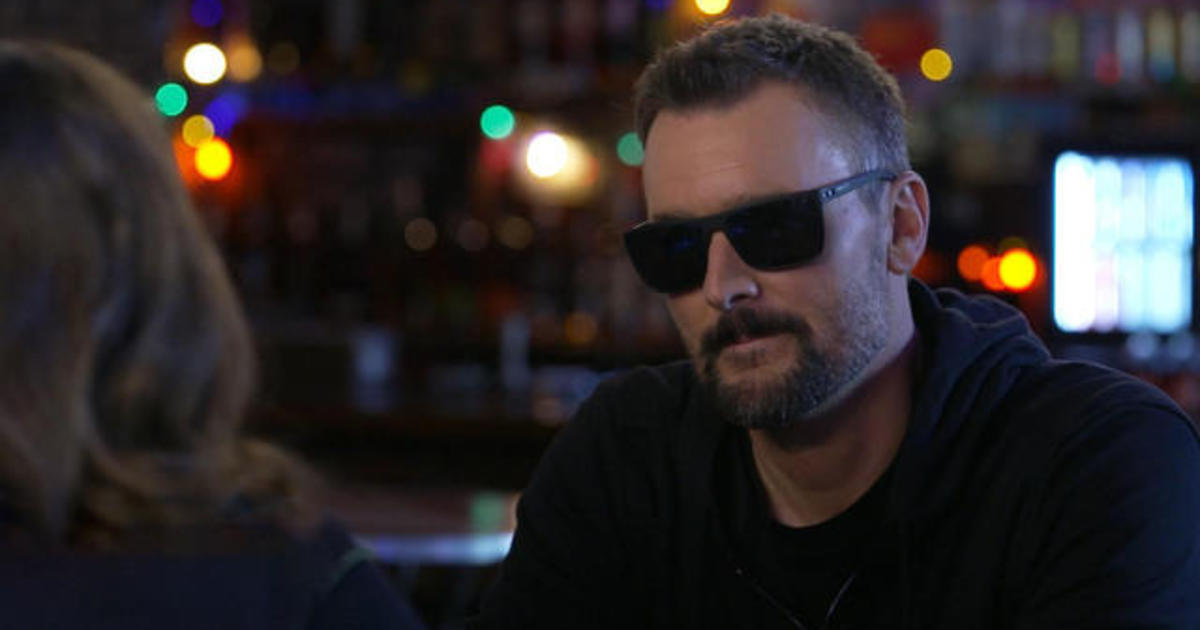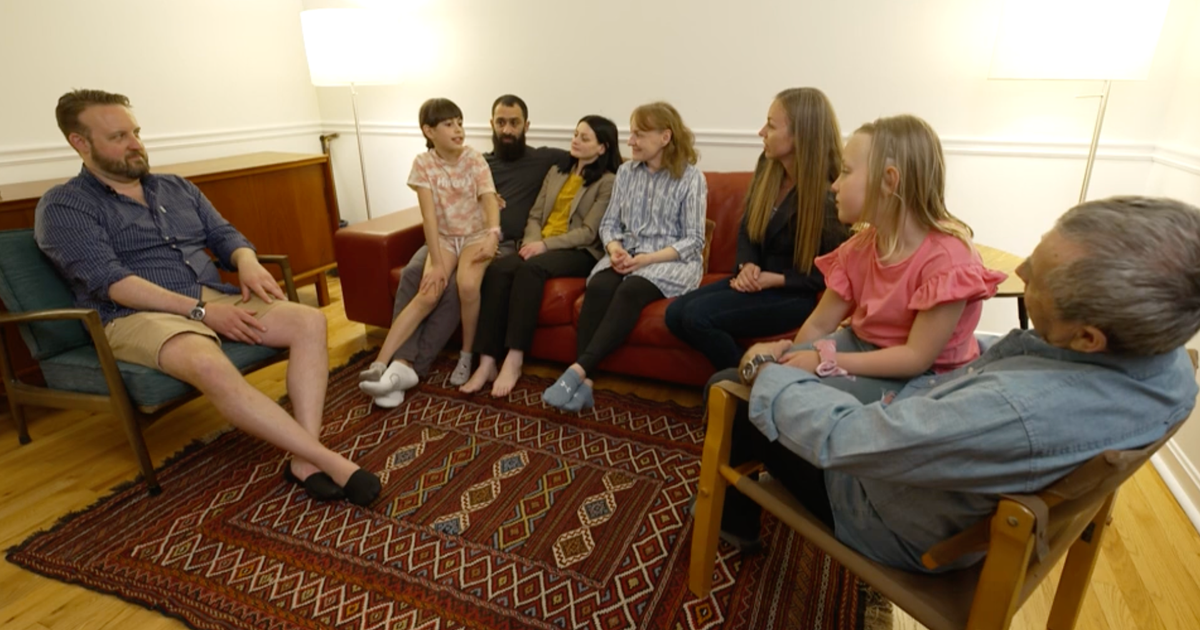Inside the Vatican
Whether you’re a lover of art, a student of history, or one of the more than one billion Catholics the world over, all roads lead to the Vatican. Mo Rocca takes us there...
Vatican City is the smallest independent state in the world, an enclave tucked inside of Rome -- just 110 acres in area, with fewer than 1,000 residents. But it draws more than six million visitors each year to the monumental St. Peter’s Square, the magnificent Vatican museums and, at its heart, one of the holiest sites in the world: Saint Peter’s Basilica.
New York’s Timothy Cardinal was a 22-year-old seminarian when he first visited St. Peter’s. He described the traditional procession when a new pope is elected: “He would leave the Sistine Chapel, say a prayer at the Pauline Chapel, and then walk out here and go to the central loggia. And if you see the beautiful mosaic up there -- that’s the words of Jesus, from the 16th chapter of Matthew’s Gospel, ‘You are Peter. And upon this rock I will build my church.’
“There are certain symbols, there are certain images, especially in the mind of a Catholic, that sort of represent something awesome, and St. Peter’s would be one of those,” Dolan said. “To see this close up – you talk about something that would just shake ya’. It was great!”
St. Peter is at the center of it all -- spiritually, architecturally and literally. “I try to imagine the different people who have walked through here,” says art historian Elizabeth Lev. “I imagine the saints, all these great figures that are now up there that once actually walked through this square.
“The site of St. Peter’s Basilica, St. Peter’s Square, is all centered around the tomb of St. Peter, which is found 144 meters under that golden globe on the top of Michelangelo’s dome,” Lev said.
Built on the site where Peter (the apostle and first pope) was crucified upside-down -- martyred, along with other early Christians, by the Roman Emperor Nero in 64 A.D.
“It was Peter who said, ‘I’m not worthy to die the same way the master did. Would you crucify me upside-down?’” Dolan said.
Lev said, “So when Peter’s body was cut down off the cross he had to be buried immediately. They stuck Peter in the trench, they covered him with some dirt and that was the end of the man who was referred to as the Prince of the Apostles.”
“And does this instantly become a shrine, a place where pilgrims come?” Rocca asked.
“Even though that tomb is so inauspicious, this is where the whole story begins.”
And what a story! The Basilica is a marvel. Started in 1506, it’s the work of 12 architects and a roster of Renaissance masters, serving 20 popes over the course of 120 years.
What’s miraculous, says Lev, is that it all came together so beautifully: “Imagine the dome looks like it’s hovering above Peter’s tomb directly below. And when the Pope steps up to his altar underneath Bernini’s canopy, stepping in the footsteps of Peter the fisherman, he is the Pontifex Maximus, the bridge between heaven and Earth. Michelangelo designed the explanation of the papacy in the interior part of the dome.”
The dome of St. Peter’s would be the crowning glory in the life of artist Michelangelo Buonarotti. And towards the front of the basilica, a much younger Michelangelo’s breakthrough work, sculpted from a single piece of marble, the Pietà.
“Pietà is the Latin and the Italian word for compassion, for mercy, for tenderness, a word particularly poignant for our present pope,” said Dolan. “So Michelangelo there has the Pietà -- in other words, the compassionate, sorrowful Mother Mar -- holding the body of Jesus as it was taken down from the cross. Now imagine how heavy that is. See, there is an extraordinarily strong woman, right? There’s a tenderness, there’s a compassion, there’s a pietà. You can almost see a surrender.”
Only a few years later, Michelangelo would paint the ceiling of the Sistine Chapel, where cardinals meet to elect a new pope, and just one of the treasures of the Vatican museums. The decision in 1780 to open those museums to the general public regardless of religion was revolutionary.
“There is a painting of the man who opened that museum, Pope Pius VI, giving a tour to King Gustav III of Sweden,” Lev said. “They are religiously on the opposite ends of the spectrum. But you see this painting of the two of them walking side-by-side, standing under the statues. That’s what the museums are -- they are a platform of dialogue.”
“Because you don’t have to be Catholic, you don’t have to be Christian, to look at the tapestry of the Risen Christ and marvel at it,” said Rocca.
The museums were opened in 1780 to everybody. “We have sketches of people coming in there, you see men in big turbans,” said Lev. “We’re assuming that they’re Muslim.”
Today the Vatican Museums, which have a great history of openness, comprise one of the largest collections in the world -- three-and-a-half miles of museum -- and the first of its magnitude to have a woman as director: Barbara Jatta. She told Rocca she felt “astonishment” when she was appointed director.
Caring for these treasures is equal parts art and science: “A huge part of the work of the museum is conservation, preservation and restoration,” she said. “Almost 100 people in seven different conservatory labs are working permanently in the museum.”
On projects like the restoration of an oil painting by Raphael in the Hall of Constantine. Overseeing this restoration is Professor Arnold Nesselrath. “As the restorer, you have to be humble. You have to accept that what you’re working on is much greater and it’s much more important than the work you do.”
Asked to define the genius of Raphael, Nesselrath said, “What he does with the light, how he translates the light into painting. This is, I think, the masterpiece in this room. It’s the last we have of Raphael when he dies at the age of 37. And it’s also the idea of what we lost.
“And it makes us understand why the whole of Rome was sad, when they heard on Good Friday in 1520 that he’d died.”
And how did he die? “Contemporaries say from too much love.”
“What? Like, had too much sex?” Rocca asked.
“That’s the impression that his biographers give to posterity.”
“He just exhausted himself? He really lived life to the fullest, for at least a short time.”
When asked if he’s learned something that really surprised him, Nesselrath replied, “We discovered the beans that came from the New World, and which the workmen who applied the plaster, they’d fallen into the plaster, when they went and took the plaster and smashed it to the wall and smoothed it over, the beans remained in there.”
It’s nice to know that Americans played such a vital part in its creation.
And today Americans pay for much of the restoration through the Vatican’s Patrons of the Arts program. Cardinal Dolan explained, “These works of art belong to the whole world. We only hold them as a custodian, as a steward. They belong to everybody.”
On the day we were in the Basilica with Cardinal Dolan, it was beautifully illuminated for the Feast of the Chair of Peter, a magnificent bronze- and iron-encrusted chair. “The chair represents unity and teaching -- and so the successor of Peter, the pope.”
“All the threads and the roads of the Vatican museums lead back to the presence of Peter,” said Lev. “We are perhaps the most beautiful outgrowth and offshoot, at least in art and architecture, that comes from that seed that was planted 2,000 years ago.”
Geographically, Vatican City may be small. But just like Bernini’s Colonnade in St. Peter’s Square, its arms open wide to the world.
For more info:
